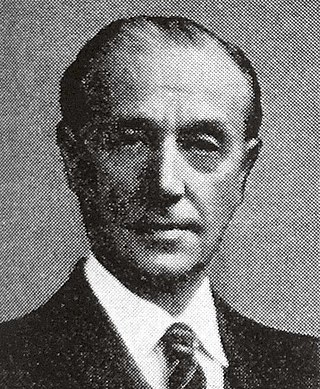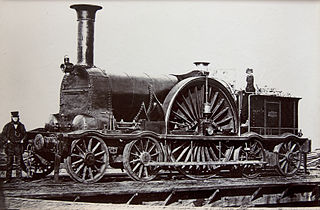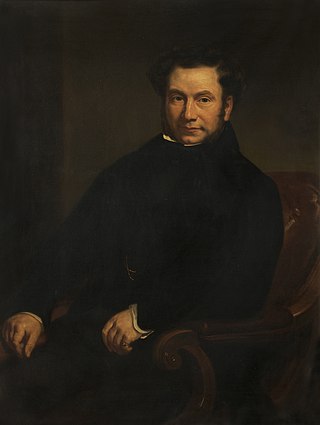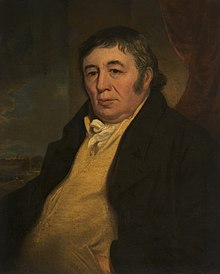
A Fairlie locomotive is a type of articulated steam locomotive that has the driving wheels on bogies. The locomotive may be double-ended or single ended. Most double-ended Fairlies had wheel arrangements of 0-4-4-0T or 0-6-6-0T.

Oliver Vaughan Snell Bulleid CBE was a British railway and mechanical engineer best known as the Chief Mechanical Engineer (CME) of the Southern Railway between 1937 and the 1948 nationalisation, developing many well-known locomotives.

In the Whyte notation for the classification of steam locomotive wheel arrangement, an 0-4-4-0 is a locomotive with no leading wheels, two sets of four driving wheels, and no trailing wheels. The arrangement is chosen to give the articulation of a locomotive with only the short rigid wheelbase of an 0-4-0, but with its weight spread across eight wheels, and with all the weight carried on the driving wheels; effectively a flexible 0-8-0. Articulated examples were constructed as Mallet, Meyer, BMAG and Double Fairlie locomotives and also as geared locomotives such as Shay, Heisler, and Climax types. A similar configuration was used on some Garratt locomotives, but it is referred to as 0-4-0+0-4-0. In the electric and diesel eras, the Bo-Bo is comparable and closest to the Meyer arrangement of two swivelling bogies.
Under the Whyte notation for the classification of steam locomotives, 0-8-0 represents the wheel arrangement of no leading wheels, eight powered and coupled driving wheels on four axles and no trailing wheels. Locomotives of this type are also referred to as eight coupled.

Under the Whyte notation for the classification of steam locomotives, 4-2-4 represents the wheel arrangement of four leading wheels on two axles, two powered driving wheels on one axle, and four trailing wheels on two axles.
The Bolton and Leigh Railway (B&LR) was the first public railway in Lancashire. It opened for goods on 1 August 1828, and thus preceded the Liverpool and Manchester Railway (L&MR) by two years. Passengers were carried from 1831. The railway operated independently until 1845 when it became part of the Grand Junction Railway.
A Meyer locomotive is a type of articulated locomotive that has two separate bogies, upon which the boiler and firebox swivel. The design was never as popular as the Garratt or Mallet locomotives. It can be best regarded as 19th Century competition for the early compound Mallet and also the Fairlie articulated designs. Most single cab modern trains are of a similar design such as power cars, freight diesel locomotives, and some passenger locomotives.

Benjamin Hick was an English civil and mechanical engineer, art collector and patron whose improvements to the steam engine and invention of scientific tools were held in high esteem by the engineering profession; some of Hick's improvements became public property without claiming the patent rights he was entitled to or without their source being known.
B. Hick and Sons, subsequently Hick, Hargreaves & Co, was a British engineering company based at the Soho Ironworks in Bolton, England. Benjamin Hick, a partner in Rothwell, Hick and Rothwell, later Rothwell, Hick & Co., set up the company in partnership with two of his sons, John (1815–1894) and Benjamin Jr (1818–1845) in 1833.
George Forrester and Company was a British marine engine and locomotive manufacturer at Vauxhall Foundry in Liverpool, established by Scottish engineer George Forrester. The company opened in 1827 as iron founders and commenced building steam locomotives in 1834.

The Beugniot lever (Beugniot-Hebel) is a mechanical device used on a number of locomotives to improve curve running. It was named after its inventor Édouard Beugniot.

The Elsässische Maschinenbau-Gesellschaft Grafenstaden was a heavy industry firm located at Grafenstaden in the Alsace, near the city of Strasbourg.

Córas Iompair Éireann No. CC1, generally known as the Turf Burner, was a prototype 0-6-6-0 articulated steam locomotive designed by Oliver Bulleid to burn turf and built at CIÉ's Inchicore Works in Dublin. CC1 shared some, but not all, of the characteristics of Bulleid's previous attempt to develop a modern steam locomotive, the Leader. Like the one completed Leader, CC1 had a relatively short career and was never used in front-line service. It was the last steam locomotive to be constructed for an Irish railway.

John Hick was a wealthy English industrialist, art collector and Conservative Party politician who sat in the House of Commons from 1868 to 1880, he is associated with the improvement of steam-engines for cotton mills and the work of his firm Hick, Hargreaves and Co. universal in countries where fibre was spun or fabrics woven.
The Société Alsacienne de Constructions Mécaniques, or SACM, is an engineering company with its headquarters in Mulhouse, Alsace, which produced railway locomotives, textile and printing machinery, diesel engines, boilers, lifting equipment, firearms and mining equipment. SACM also produced the first atomic reactor at Marcoule.

The South African Railways Class FC 2-6-2+2-6-2 of 1925 was an articulated steam locomotive.
The Koechlin family are a French Alsatian family which acquired its wealth in the textile industry and became leading industrialists and politicians of the region.

Édouard Beugniot (1822-1878) was a French engineer, designer of the Beugniot lever, a system for articulating the driving axles of railway locomotives.

The Nord 2.821 to 2.911 and 2.201 to 2.212, also referred to as Outrances, was a series of French 2-4-0 and 4-4-0 express passenger locomotives of the Chemins de Fer du Nord.













